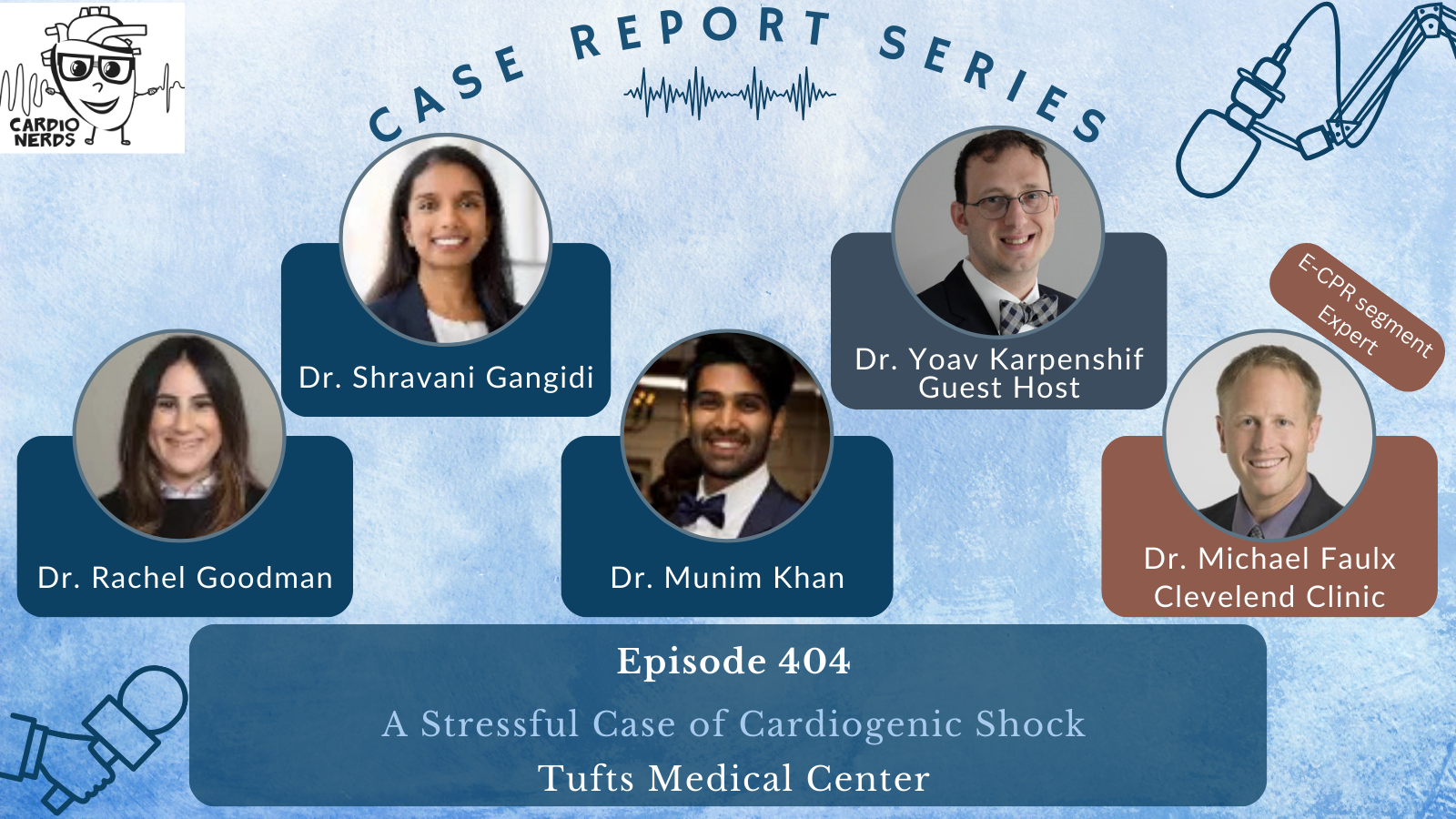
404. Case Report: A Stressful Case of Cardiogenic Shock – Tufts Medical Center
Cardionerds: A Cardiology Podcast
Intro
This chapter focuses on a complex case of cardiogenic shock discussed by speakers at Tufts Medical Center, featuring a group of fellows. The session highlights the importance of critical care cardiology, emphasizing real-life applications of medical knowledge and teamwork.

CardioNerds (Dr. Dan Ambinder and Dr. Yoav Karpenshif – Chair of the CardioNerds Critical Care Cardiology Council) join Dr. Munim Khan, Dr. Shravani Gangidi, and Dr. Rachel Goodman from Tufts Medical Center’s general cardiology fellowship program for hot pot in China Town in Boston. They discuss a case involving a patient who presented with stress cardiomyopathy leading to cardiogenic shock. Expert commentary is provided by Dr. Michael Faulx from the Cleveland Clinic. Notes were drafted by Dr. Rachel Goodman. Audio editing by Dr. Diane Masket.
A young woman presents with de novo heart-failure cardiogenic shock requiring temporary mechanical circulatory support who is found to have basal variant takotsubo cardiomyopathy. We review the definition and natural history of takotsubo cardiomyopathy, discuss initial evaluation and echocardiographic findings, and review theories regarding pathophysiology of the clinical syndrome. We also highlight complications of takotsubo cardiomyopathy, with a focus on left ventricular outflow obstruction, cardiogenic shock, and arrythmias.
“To study the phenomena of disease without books is to sail an uncharted sea, while to study books without patients is not to go to sea at all.” – Sir William Osler. CardioNerds thank the patients and their loved ones whose stories teach us the Art of Medicine and support our Mission to Democratize Cardiovascular Medicine.
US Cardiology Review is now the official journal of CardioNerds! Submit your manuscript here.
Pearls
- Takotsubo cardiomyopathy is defined as a reversible systolic dysfunction with wall motion abnormalities that do not follow a coronary vascular distribution.
- Takotsubo cardiomyopathy is a diagnosis of exclusion; patients often undergo coronary angiography to rule out epicardial coronary artery disease given an overlap in presentation and symptoms with acute myocardial infarction.
- There are multiple echocardiographic variants of takotsubo. Apical ballooning is the classic finding, but mid-ventricular, basal, and biventricular variants exist as well.
- Patients with takotsubo cardiomyopathy generally recover, but there are important complications to be aware of. These include arrhythmia, left ventricular outflow tract (LVOT) obstruction related to a hyperdynamic base in the context of apical ballooning, and cardiogenic shock.
- Patients with Impella devices are at risk of clot formation and stroke. Assessing the motor current can be a clue to what is happening at the level of the motor or screw.
Notes
What is Takotsubo Syndrome (TTS)?
- TTS is a syndrome characterized by acute heart failure without epicardial CAD with regional wall motion abnormalities seen on echocardiography that do not correspond to a coronary artery territory (see below).1
- TTS classically develops following an acute stressor—this can be an emotional or physical stressor.1
- An important feature of TTS is that the systolic dysfunction is reversible. The time frame of reversibility is variable, though generally hours to weeks.2
- Epidemiologically, TTS has a predilection for post-menopausal women, however anyone can develop this syndrome.1
- TTS is a diagnosis of exclusion. Coronary artery disease (acute coronary syndrome, spontaneous coronary artery dissection, coronary embolus, etc) should be excluded when considering TTS. Myocarditis is on the differential diagnosis.
What are the echocardiographic findings of takotsubo cardiomyopathy?
- The classic echocardiographic findings of TTS is “apical ballooning,” which is a way of descripting basal hyperkinesis with mid- and apical hypokinesis, akinesis, or dyskinesis.3
- There are multiple variants of TTS. The four most common are listed below:3
- (1) Apical ballooning (classic TTS)
- (2) Mid-ventricular variant
- (3) Basal variant
- (4) Focal variant
- Less common variants include the biventricular variant and the isolated right ventricular variant.3
Do patients with TTS generally have EKG changes or biomarker elevation?
- Patients often have elevated troponin, though the severity wall motion abnormalities seen on TTE is generally out of proportion to the degree of troponin elevation.4
- BNP/NTproBNP are typically elevated, especially early in the course.4
- During the acute phase (defined as within the first 12 hours), patients may have ST elevation or depression, T wave inversions, new LBBB, or QT prolongation.4
What are complications of takotsubo cardiomyopathy?
- Heart failure2
- LV outflow tract obstruction—if there is an LVOT obstruction, it is important to avoid diuretics, vasodilators such as nitroglycerin, and inotropic agents.2
- Cardiogenic shock.2
- Atrial and ventricular arrhythmias.2
- LV thrombus—this is of particular risk in patients with the classic “apical ballooning” variant of takotsubo due to apical akinesis and therefore stagnant flow.2
References
- Lyon AR, Citro R, Schneider B, et al. Pathophysiology of Takotsubo Syndrome. J Am Coll Cardiol. 2021;77(7):902-921. doi:10. 1016/j.jacc.2020.10.060
- Singh T, Khan H, Gamble DT, Scally C, Newby DE, Dawson D. Takotsubo Syndrome: Pathophysiology, Emerging Concepts, and Clinical Implications. Circulation. 2022;145(13):1002-1019. doi:10.1161/CIRCULATIONAHA.121.055854
- Ghadri JR, Wittstein IS, Prasad A, et al. International Expert Consensus Document on Takotsubo Syndrome (Part I): Clinical Characteristics, Diagnostic Criteria, and Pathophysiology. Eur Heart J. 2018;39(22):2032-2046. doi:10.1093/eurheartj/ehy076
- Current state of knowledge on Takotsubo syndrome: a Position Statement from the Taskforce on Takotsubo Syndrome of the Heart Failure Association of the European Society of Cardiology – Lyon – 2016 – European Journal of Heart Failure – Wiley Online Library


